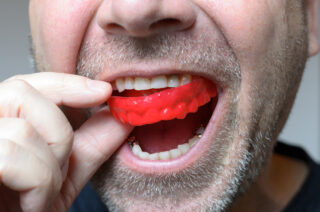
More Dental Health Articles
Traumatic Dental Injuries

Traumatic dental injuries can occur in people of all ages and activity levels. The cause might be a car accident, a fall down the stairs, or an elbow to the face during a basketball game. As with most types of dental treatment, the primary goal when treating a traumatic dental injury is to save teeth at risk of being lost, and restore them to full function and normal appearance.
Here are some guidelines on how to prevent sports-related dental injuries and what to do after a dental injury occurs.
Sports-Related Dental Injuries
Dental trauma accounts for a significant portion of all sports injuries, yet so many of these injuries are preventable with a high-quality mouthguard. A good mouthguard is one of the best investments you can make in sports equipment.
The best kind of mouthguard is one that comes from your dentist’s office. It’s custom-made from a model of your own teeth, so it’s strong, lightweight, and perfectly fitted. If you (or your child) are active in sports, ask about this indispensable piece of safety gear. And continue reading below to find out what to do in the case of specific types of dental injuries.
Chipped Or Broken Teeth
Chipped teeth are the most common dental injury. If teeth have been chipped or fractured, or if they are loose or tender to the touch, make sure to see a dentist within 12 hours. Try to locate any pieces of the tooth that have come off, as it may be possible to reattach them to the crown with tooth-colored bonding material.
Knocked-Out Teeth
If a permanent tooth has been knocked out of its socket (avulsed), immediate attention is required. First, recover the tooth – and if it’s dirty, gently clean it off with water. Try not to touch the root portion of the tooth. Next, if possible, place the tooth back into its socket (making sure it is in the proper orientation), and apply gentle, sustained pressure to the area for five minutes. You can use a wad of wet tissue or gauze to help grasp and hold the tooth in place. Get emergency dental treatment as soon as possible afterward, and be sure to check whether a tetanus shot or booster is needed.
If it isn’t possible to replant the tooth, have the patient hold it between his teeth and cheek, or place it into a plastic bag with the patient’s saliva, or into a cup of cold milk. Control bleeding from the tooth socket by applying pressure to the area (use gauze if possible), and get the patient and the tooth to an emergency treatment center as soon as possible.
Other Articles You May Find of Interest...
- The Importance of Phase I Orthodontic Treatment for Children Aged 8-10
- Retainers in Riverdale, NY: Choosing the Best Option for Your Smile
- Discover Top-Quality Dental Care in Rockford IL
- Pregnancy & Hormonal Gingivitis: An Essential Guide
- Straighten Your Teeth, Improve Your Health
- Dental Implants For Edentulous Patients
- Dental X-Rays Explained: Procedures, Uses, And Frequency

















